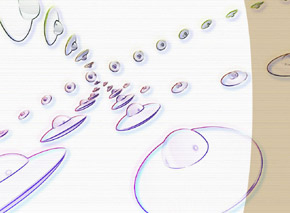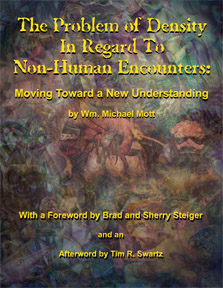-
WAY DOWN, BENEATH THE OCEAN DEPARTMENT -
She-Devils of the Deep
She-Devils of the Deep

Fishermen have long been renowned for tall
tales but perhaps the
tallest of all are those about mermaids.
Mermaid legends are centuries
old and have a degree of similarity,
irrespective of which country they
come from. All depict the creature as
half-human, half-fish and
sightings are generally said to be ill
omens, foretelling bad storms,
rough seas and even death on the waves.
With the exception of Mami Wata, the West African mermaid goddess who was said to possess healing powers, most mermaid stories are of fearsome sirens luring men to their watery graves. It's only in the last 50 years that the mermaids' reputation got a romantic makeover thanks to Hollywood and Disney, with films such as The Little Mermaid and Splash.
One night the painting came to life
Older versions of these stories say that mermaids yearn for a soul, which they can only get by marrying a human, hence their stalker-like behaviour with men. Holistic therapist Carina Coen believes she was a mermaid in a past life following an unusual experience. She says: 'I have a hand-painted picture of a dolphin and a mermaid on my wall at home. One night the painting came to life. It was as though the top part of the room became deep sea water and the mermaid floated above me, singing and talking with incredible passion.'
The mermaid told Coen that her mission on Earth was to 'return others to their inner soul life journey' and urged her to help awaken people to the ways they are destroying the seas.
While most people will think it a likely story and even Coen admits her encounter seems surreal, she is absolutely convinced her experience was as dramatic as a flesh-and- blood sighting.
The last reported mermaid sighting was in 1947 when newspaper reports told of a fisherman on the Isle of Muck in the Scottish Highlands who said he had seen a mermaid sitting on a lobster pot near the shore combing her hair. Hoaxes have also dented the idea of mermaids being real. The most famous of these was the Fiji mermaid, purportedly found by Japanese fishermen near the Fiji Islands, and brought to the New York-based American Museum in 1842. This ugly creature was found to be a composite of papier m?chŽ, a baby orangutan, a monkey head and bits of different fish. Perhaps the most recent hoax came from Chennai after the Indian Ocean tsunami in 2004. The so-called mermaid was once again made up of primate and fish parts.
Marine biologist Dr Vicki Howe, of Cardiff University, is adamant there are no such things as mermaids.
'There are many strands of evolution, of which fish and mammals are just two,' she says. 'Both humans and fish are vertebrates. However, these are two divergent evolutionary pathways and mammals are warm-blooded whereas fish are cold-blooded. That is a good starting point for refuting the existence of a fish-human hybrid.' It has been suggested that sightings of mermaids may be dugongs, or sea cows, that swim in shallow waters.
'It's nice to think dugongs, that are huge graceful animals with soft smiling faces, could be mistaken for mermaids,' says Howe. 'Sailors on long journeys at sea, working hard with poor diets and plenty of grog, may have resorted to wishful thinking.'
Source: Metro
http://www.metro.co.uk/weird/article.html?in_article_id=15494&in_page_id=2
With the exception of Mami Wata, the West African mermaid goddess who was said to possess healing powers, most mermaid stories are of fearsome sirens luring men to their watery graves. It's only in the last 50 years that the mermaids' reputation got a romantic makeover thanks to Hollywood and Disney, with films such as The Little Mermaid and Splash.
One night the painting came to life
Older versions of these stories say that mermaids yearn for a soul, which they can only get by marrying a human, hence their stalker-like behaviour with men. Holistic therapist Carina Coen believes she was a mermaid in a past life following an unusual experience. She says: 'I have a hand-painted picture of a dolphin and a mermaid on my wall at home. One night the painting came to life. It was as though the top part of the room became deep sea water and the mermaid floated above me, singing and talking with incredible passion.'
The mermaid told Coen that her mission on Earth was to 'return others to their inner soul life journey' and urged her to help awaken people to the ways they are destroying the seas.
While most people will think it a likely story and even Coen admits her encounter seems surreal, she is absolutely convinced her experience was as dramatic as a flesh-and- blood sighting.
The last reported mermaid sighting was in 1947 when newspaper reports told of a fisherman on the Isle of Muck in the Scottish Highlands who said he had seen a mermaid sitting on a lobster pot near the shore combing her hair. Hoaxes have also dented the idea of mermaids being real. The most famous of these was the Fiji mermaid, purportedly found by Japanese fishermen near the Fiji Islands, and brought to the New York-based American Museum in 1842. This ugly creature was found to be a composite of papier m?chŽ, a baby orangutan, a monkey head and bits of different fish. Perhaps the most recent hoax came from Chennai after the Indian Ocean tsunami in 2004. The so-called mermaid was once again made up of primate and fish parts.
Marine biologist Dr Vicki Howe, of Cardiff University, is adamant there are no such things as mermaids.
'There are many strands of evolution, of which fish and mammals are just two,' she says. 'Both humans and fish are vertebrates. However, these are two divergent evolutionary pathways and mammals are warm-blooded whereas fish are cold-blooded. That is a good starting point for refuting the existence of a fish-human hybrid.' It has been suggested that sightings of mermaids may be dugongs, or sea cows, that swim in shallow waters.
'It's nice to think dugongs, that are huge graceful animals with soft smiling faces, could be mistaken for mermaids,' says Howe. 'Sailors on long journeys at sea, working hard with poor diets and plenty of grog, may have resorted to wishful thinking.'
Source: Metro
http://www.metro.co.uk/weird/article.html?in_article_id=15494&in_page_id=2
-
IS THERE ANYBODY OUT THERE DEPARTMENT -
Korendor Calling: Alien Radio Contact
Korendor Calling: Alien Radio Contact

"In the wee hours of the morning, when the first golden rays of the sun were probing the black veil of a cold December night for an opening through which to illuminate the world, I held my ninth radio communication with people from another planet."
Be alerted, reader: That is not the opening line from a science fiction novel, though it would probably play well in that context. Instead, those were the words with which a Berkshires man named Bob began his account of his years of personal contact with the Korendians.
It all began in July 1961, when the then 18-year-old radio buff was browsing around the short-wave bands with his equipment, "searching for something interesting to listen to," and finally selected a BBC station. It was not long before an irritating noise disturbed his listening, and as he attempted to identify its cause, a clear, feminine voice spoke out from his headphones, "Bob, we'd like you to stay on this frequency for a while."
The voice proceeded to introduce herself as Lin-Erri, a native of the planet Korendor, speaking to him from a spacecraft several miles from Earth.
By his own account, Bob was understandably dumbfounded. He notes that he had read a couple of books and some newspaper articles on the subject of flying saucers (as had quite a substantial part of the American population by 1961), but he described himself as "still somewhat skeptical of such things." Before that, in a 1958 letter to the editor that appeared in the Berkshire Evening Eagle, this same young man had stated that, based on his reading (which included notorious extraterrestrial contactee claimant George Adamski's book "Flying Saucers Have Landed"), he was "inclined to inclined to accept for fact the existence of the extraterrestrial beings and their spacecraft."
Still, there's believing in aliens, and then there's having aliens chat you up one evening.
Lin-Erri told Bob that her people had become interested in the mountains of the Berkshires, specifically in a certain unnamed material to be found there that was useful to some of their electronic devices. Lin-Erri and her companions became interested in speaking to Bob because of his interest in UFOs, as well as in "world peace and the future of mankind." She gave him instructions on how to upgrade his equipment in order to have two-way communication with him, and from that time on, Bob spoke with Lin-Erri and other Korendians frequently.
Their home planet, they said, was very similar to Earth but with a higher percentage of oxygen in the atmosphere. Korendor was the third planet in the 12-planet system orbiting the star Korena, which lay about three degrees from Arcturus in the constellation Bootes, not visible from Earth with our current telescopic technology. In appearance, the Korendians are not unlike us; although typically shorter in stature, they appear similar enough to travel and work among us without notice.
Bob described his continued contacts with the Korendians in articles that were published in UFO International between 1963 and 1969. These accounts, along with some supplemental information, were later gathered into a privately printed book "UFO Contact From Korendor," e-book versions of which are still available on the Internet.
He describes finally meeting with representatives of the Korendian race, including Lin-Erri and others, traveling in their spacecraft and visiting their underground base in the Berkshires. His accounts included detailed descriptions of their technology, diagrams of their vehicles and even photographs of alleged flying saucers, of which I was only able to obtain some murky Xeroxes.
The majority of the material he presented consisted of transcriptions of conversations, primarily messages and social diatribes from his Korendian contacts. At times, his story reads like a "100 ways Korendor is better than Earth" list.
The Korendians seem to have had a very progressive platform, even for the '60s: Besides denunciation of war, atomic weapons and racial inequality, they preached a possible salvation for humanity intertwining both greater technology and greater morality, a more conscious existence free of "dangerous emotionalism." They predicted that communism in its current tyrannous incarnation would collapse under its own weight and that the West should try to coexist peaceably with it in the meantime. Korendians were even said to have been behind the Great Northeast Blackout of 1965, in order to prompt the United States to modify and upgrade its grid system.
There's more to Bob's story - hundreds of pages of testimony recounting his encounters with the Korendians. Later, at least two other individuals, John W. Dean and Cameron Colin Boyd, also reported contacts with the kindly folk from Korendor. Dean's are described in his book "Flying Saucers Close-up," along with what he maintains are examples of Korendian writing and vocabulary. But Bob maintains to this day that he is the only Korendian contact, and that others who have made such claims are either frauds or victims of deception by forces aligned against the Korendian cause.
As to the veracity and potential significance of Bob's reports, different people have come to different conclusions. Gabriel Green, editor of UFO International, embraced and published his accounts, couching them with enthusiastic editorial notes. They were also championed by retired Air Force pilot-turned-UFO-investigator Wendelle Stevens, who had them published in book form.
Whitley Strieber notes that the name Lin-Erri phonetically translates into the Gaelic "body of light," drawing parallels between the Korendians and ancient lore of the Sidhe or Faerie beings, right down to their underground realms. UFO theorist John Keel suggests that they, along other UFO beings, fairies and so forth down through the ages, are all "ultraterrestrials" - beings of sort of semi-material, daemonic dimensional reality, bordering ours.
Generally speaking, though, even among the admittedly fringe pursuit of ufology, this type of "contactee" narrative, most famously associated with George Adamski, is treated with little credibility and rarely is seriously discussed in UFO circles today. One skeptic, though, ufologist Allan Grise, came to the Berkshires to visit Bob at his home and was intrigued by what he found.
A professional engineer and ham-radio buff, Grise looked at Bob's equipment and found that "everything seemed to make sense. The circuits were all appropriate to extend the receiving range." He also listened to some tapes purported to be of conversations with Lin-Erri, whose voice he describes as having "a singsong, melodious quality" and whose halting speech patterns suggested someone foreign managing well in English.
Bob stayed out of the contactee scene of conventions and lecture circuits, confining his public face to his written accounts. Grise found him to be uninterested in self-promotion - volunteering little but amenable to questions. Over e-mail exchanges, I found it to be similar: He was resistant to the idea of any press coverage but was kind enough to clarify some points for me. He's not loopy-schizophrenic, megalomaniacal - anything like that - and I've dealt with "UFO nuts," believe me.
As for the UFO base in the Berkshires (vague rumor of which initially lead me to Bob's story) various Internet sites identify Mount Everett as being the site of an underground alien base, but Bob tells me he knows nothing about that. As to where exactly the base he described in his claims is located - and whether or not he still has involvement with the Korendians, Bob only jokes, "I could tell you, but then I'd have to kill you."
If his story IS a fabrication, he deserves to take his rightful place alongside Orson Welles, L. Ron Hubbard, Lovecraft and other great science-fiction crossover artists. I, like most people, might have a hard time endorsing the idea of such a vast extraterrestrial presence going so secretly among us. It's not such a bad scenario, though, should it someday turn out that Bob was right all along. These Korendians seem like nice enough blokes, provided they don't end up being rodent-eating reptiles underneath, with books on "How to Serve Man."
Source: The Advocate Weekly
http://advocateweekly.com/columns/ci_3940408
The 120-Year-Old Mind-Reading Machine
By Adrienne LaFrance

In the 1890s, when
technologies like telephones and automobiles
and lightbulbs were still strange and
wonderful and new, inventors promised
another remarkable device would soon be
ubiquitous: the mind-reading machine.
Inspired by the phonoautograph—a new device that showed what sound waves looked like on paper—the scientist Julius Emmner invented a machine that he said could record thoughts. It was simple, really. If invisible sound vibrated in a ways that could be measured, Emmner figured, why wouldn't unseen thoughts do the same?
"Sound is addressed to the ear," he told The Times of Washington, D.C., in August 1895, "yet it may be made visible, a proof of which fact is found in the phono-autograph, in which the vibrations of sound are made distinctly visible." Reporters took him at his word. From that same article: "Mr. Emmner is carefully guarding his secret, but he speaks so enthusiastically of his success that he must have obtained the most satisfactory results so far from his investigations."
Reports of thought-reading machines were common in those days. "Secrets will cease to be hidden in the day when the perfected psychometer comes into general use," the Seattle Star declared in a 1908 article about Columbia University professor Frederick Peterson's lie-detector-esque "mind-reading machine."
Peterson's device was made out of a mirror, a lamp, a horizontal glass scale, and a galvanometer—a tool to measure electric current. It was designed to shine light on a person whose hands would be resting on copper-plate electrodes. That person would be instructed to say any words that came to mind, and if the beam of light shining on him moved more than 6 to 8 centimeters in response, Peterson interpreted it as a "complex" emotion.
Okaaay. So it doesn't exactly sound like the "instrument of precision" the Star claimed it to be, but coverage of Peterson's apparatus clearly highlights the era's cultural obsession with mind-reading as the next big thing in technology. By 1910, a British psychologist claimed that thoughts vibrated enough to be discernible to those "constantly attuned" to the phenomenon. Others in academia focused on the visible form a thought might take—what colors could thoughts be? And what would those different colors mean? In 1938, The New York Times called the idea of a thought-reading machine "delightfully plausible."
Decades of neuroscience research later, most of these mind-reading designs sound absurd. But you can't blame people for wanting to believe. The best real-life technology begins with marvelous, outlandish ideas. Consider the technological advances that adults of the late 1800s had just lived through: Humans could now be captured on camera (1838), there were devices that could snatch sound from the air and record it (1860), people in different houses could have real-time voice conversations by talking into machines (1876), and electric lights had just been installed in the White House (1891)!
The concept of recorded sound was still so new in the 1890s that it seemed reasonable—or at least the tiniest bit possible—to think recorded sound might be a precursor to recorded thought. Sounds had always been something you heard once, while they happened, and never again.
And if you haven't tried recording someone's thoughts, how do you know you can't do it? In the same way that if you haven't seen the surface of the moon, why shouldn't you be open to the idea of moon elephants roaming on it? When a new telescope was debuted in Paris in 1899, The Times (of Richmond, Virginia) called it the "telescope by which animals as large as an elephant can be plainly seen upon the moon" and promised it would "show us the large animals upon the moon and their movements."
It was an age of mind-reading machines, and moon elephants, and horse-powered hippocycles and video telephones.
The promise of a mind-reading machine was, in its day, a sort of shorthand for what might be technologically possible. And a willingness to believe—or at least to explore—such an idea reflects the kind of optimism that's still essential to invention. The culture of what could be is part of how we organize all kinds of ideas about the world. It's in that same spirit today that we talk about the promises of stem cell research and gene therapies, advances in cryogenics and artificial intelligence, the search for life on other planets, etc.
And yet there's an irresistible construct about technology of the past, a way of thinking that obsesses over what we got wrong. It's that part of you that says: Of course we don't have mind-reading devices. And this is kind of funny because we tend to swing to the opposite extreme when considering possibilities for the future. A machine that does simple math isn't just a useful new tool but something that "will supplant brains."
But that "mechanical brain" didn't supplant the human brain any more than Julius Emmner's secret machine read minds. World-changing technology has never been about devices or machines, but rather people's interactions with them. Only by pushing the boundaries of what's possible can we discover what's real.
Scientists, by the way, are still designing mind-reading experiments.
Source: The Atlantic
http://www.theatlantic.com/technology/archive/2014/06/the-120-year-old-mind-reading-machine/372838/
Inspired by the phonoautograph—a new device that showed what sound waves looked like on paper—the scientist Julius Emmner invented a machine that he said could record thoughts. It was simple, really. If invisible sound vibrated in a ways that could be measured, Emmner figured, why wouldn't unseen thoughts do the same?
"Sound is addressed to the ear," he told The Times of Washington, D.C., in August 1895, "yet it may be made visible, a proof of which fact is found in the phono-autograph, in which the vibrations of sound are made distinctly visible." Reporters took him at his word. From that same article: "Mr. Emmner is carefully guarding his secret, but he speaks so enthusiastically of his success that he must have obtained the most satisfactory results so far from his investigations."
Reports of thought-reading machines were common in those days. "Secrets will cease to be hidden in the day when the perfected psychometer comes into general use," the Seattle Star declared in a 1908 article about Columbia University professor Frederick Peterson's lie-detector-esque "mind-reading machine."
Peterson's device was made out of a mirror, a lamp, a horizontal glass scale, and a galvanometer—a tool to measure electric current. It was designed to shine light on a person whose hands would be resting on copper-plate electrodes. That person would be instructed to say any words that came to mind, and if the beam of light shining on him moved more than 6 to 8 centimeters in response, Peterson interpreted it as a "complex" emotion.
Okaaay. So it doesn't exactly sound like the "instrument of precision" the Star claimed it to be, but coverage of Peterson's apparatus clearly highlights the era's cultural obsession with mind-reading as the next big thing in technology. By 1910, a British psychologist claimed that thoughts vibrated enough to be discernible to those "constantly attuned" to the phenomenon. Others in academia focused on the visible form a thought might take—what colors could thoughts be? And what would those different colors mean? In 1938, The New York Times called the idea of a thought-reading machine "delightfully plausible."
Decades of neuroscience research later, most of these mind-reading designs sound absurd. But you can't blame people for wanting to believe. The best real-life technology begins with marvelous, outlandish ideas. Consider the technological advances that adults of the late 1800s had just lived through: Humans could now be captured on camera (1838), there were devices that could snatch sound from the air and record it (1860), people in different houses could have real-time voice conversations by talking into machines (1876), and electric lights had just been installed in the White House (1891)!
The concept of recorded sound was still so new in the 1890s that it seemed reasonable—or at least the tiniest bit possible—to think recorded sound might be a precursor to recorded thought. Sounds had always been something you heard once, while they happened, and never again.
And if you haven't tried recording someone's thoughts, how do you know you can't do it? In the same way that if you haven't seen the surface of the moon, why shouldn't you be open to the idea of moon elephants roaming on it? When a new telescope was debuted in Paris in 1899, The Times (of Richmond, Virginia) called it the "telescope by which animals as large as an elephant can be plainly seen upon the moon" and promised it would "show us the large animals upon the moon and their movements."
It was an age of mind-reading machines, and moon elephants, and horse-powered hippocycles and video telephones.
The promise of a mind-reading machine was, in its day, a sort of shorthand for what might be technologically possible. And a willingness to believe—or at least to explore—such an idea reflects the kind of optimism that's still essential to invention. The culture of what could be is part of how we organize all kinds of ideas about the world. It's in that same spirit today that we talk about the promises of stem cell research and gene therapies, advances in cryogenics and artificial intelligence, the search for life on other planets, etc.
And yet there's an irresistible construct about technology of the past, a way of thinking that obsesses over what we got wrong. It's that part of you that says: Of course we don't have mind-reading devices. And this is kind of funny because we tend to swing to the opposite extreme when considering possibilities for the future. A machine that does simple math isn't just a useful new tool but something that "will supplant brains."
But that "mechanical brain" didn't supplant the human brain any more than Julius Emmner's secret machine read minds. World-changing technology has never been about devices or machines, but rather people's interactions with them. Only by pushing the boundaries of what's possible can we discover what's real.
Scientists, by the way, are still designing mind-reading experiments.
Source: The Atlantic
http://www.theatlantic.com/technology/archive/2014/06/the-120-year-old-mind-reading-machine/372838/
- DO NOT DISTURB DEPARTMENT -
Why Icelanders Are Wary of Elves Living Beneath The Rocks

Plans to build a new
road in Iceland ran into trouble recently
when campaigners warned that it would
disturb elves living in its path.
Construction work had to be stopped while
a solution was found.
From his desk at the Icelandic highways department in Reykjavik, Petur Matthiasson smiles at me warmly from behind his glasses, but firmly.
"Let's get this straight before we start - I do not believe in elves," he says.
I raise my eyebrows slightly and incline my head towards his computer screen which is displaying the plans for a new road in a neighbouring town. There are two yellow circles marked on the plans, one that reads Elf Church and another that reads Elf Chapel. Petur sighs.
"Ok," he acknowledges wearily. "But it's not every day in Iceland that we divert roads for elves. It's just in this case we were warned that elves were living in some of the rocks in the path of the road - well, we have to respect that belief." He grins shyly and picks up his car keys.
"Come on, I'll show you where the elves live," he says indulgently.
Surveys suggest that more than half of Icelanders believe in, or at least entertain the possibility of the existence of, the Huldufolk - the hidden people. Just to be clear, Icelandic elves are not the small, green, pointy-eared variety that help Santa pack the toys at Christmas - they're the same size as you and I, they're just invisible to most of us.
Mainly they're a peaceable breed but if you treat them with disrespect, for example by blasting dynamite through their rock houses and churches, they're not reticent about showing their displeasure. During our car journey, Petur tells me several stories about how elves are suspected to be behind bulldozer breakdowns and a series of workmen's accidents.
As I step out of the car at the site of the elf church a vicious gust of icy wind punches me full in the face making me stagger backwards on to the black, volcanic rock.
Iceland's rugged landscape is no bucolic idyll - the very ground boils and spits irrationally, the surrounding craggy, black mountains fester menacingly and above, the sky is constantly herniated by the iron-grey clouds it strains to hold up. It's a visceral, raw and brutal beauty which makes Heathcliff's Wuthering Heights look like a prissy, pastoral watercolour.
"You can't live in this landscape and not believe in a force greater than you," explains Professor of Folklore Adalheidur Gudmundsdottir when I visit her at the university.
She looks at me imploringly. "Please don't portray Icelanders as uneducated peasants who believe in fairies, but look around you and you'll understand why the power of folklore here is so strong," she says. It is of course also strong in the tourism trade.
On the main road into town from the airport, "Elves Live Here" signs try to lure the fanciful into spending a few thousand krona (a few pounds) on a tour of an elf village, a CD of mystical music, or for the less whimsical, perhaps an "I had Sex with an Elf in Iceland" T-shirt.
There's even an elf school in the capital at which I dutifully enrolled.
Magnus Skarphedinsson, the headmaster, a rotund, ebullient chap who ate large quantities of breakfast cereal during my one-on-one lesson, had regrettably never seen an elf himself although he did own an old cooking pot that apparently had once made stews in an elf kitchen before the bottom rusted away.
His eyes twinkled so wickedly throughout the class that at the end I asked if he wasn't some kind of malevolent fairy himself.
Petur and I have now reached the 12-foot-high jagged rock that's apparently home to the elf chapel. I scour it closely but apart from an insect or two scuttling to find some shelter in its moss-encrusted crevices, I can see no signs of any life, mythological or other. Petur eyes me suspiciously.
"I could tell you about our family elf," he begins tentatively. I encourage him to tell his tale and learn that Petur's family had a protective elf in the wild north of the country who'd brought them good fortune.
When he'd gone on a camping trip to the isolated area, his father asked him to go and pay his respects to the elf and to thank her.
"But I don't believe in elves so I sort of forgot," he says. The next day, despite the overcast sky and drizzle, he woke up so badly blistered by what appeared to be sunburn that he could barely stand.
As we turn into the blustering wind we catch each other's eye. We both have one hand gripped on to the rock with the desperation of gamblers clinging to a lucky charm. We walk back towards the car in a smug complicity of being almost non-believers.
The elf chapel and the highway
Work on the highway to link the Alftanes peninsula to the Reykjavik suburb of Gardabaer was halted when campaigners warned it would disturb elf habitat and a protected area of untouched lava.
The chapel is a 12-foot-high jagged rock.
The matter was resolved in part when a local lady who claims to talk to elves, mediated and they agreed to the road so long as their chapel was carefully moved and put elsewhere.
The highways authority will not reveal the cost of moving the rock, but says it weighs 70 tonnes and they will have to hire a crane.
Source: BBC
http://www.bbc.com/news/magazine-27907358
From his desk at the Icelandic highways department in Reykjavik, Petur Matthiasson smiles at me warmly from behind his glasses, but firmly.
"Let's get this straight before we start - I do not believe in elves," he says.
I raise my eyebrows slightly and incline my head towards his computer screen which is displaying the plans for a new road in a neighbouring town. There are two yellow circles marked on the plans, one that reads Elf Church and another that reads Elf Chapel. Petur sighs.
"Ok," he acknowledges wearily. "But it's not every day in Iceland that we divert roads for elves. It's just in this case we were warned that elves were living in some of the rocks in the path of the road - well, we have to respect that belief." He grins shyly and picks up his car keys.
"Come on, I'll show you where the elves live," he says indulgently.
Surveys suggest that more than half of Icelanders believe in, or at least entertain the possibility of the existence of, the Huldufolk - the hidden people. Just to be clear, Icelandic elves are not the small, green, pointy-eared variety that help Santa pack the toys at Christmas - they're the same size as you and I, they're just invisible to most of us.
Mainly they're a peaceable breed but if you treat them with disrespect, for example by blasting dynamite through their rock houses and churches, they're not reticent about showing their displeasure. During our car journey, Petur tells me several stories about how elves are suspected to be behind bulldozer breakdowns and a series of workmen's accidents.
As I step out of the car at the site of the elf church a vicious gust of icy wind punches me full in the face making me stagger backwards on to the black, volcanic rock.
Iceland's rugged landscape is no bucolic idyll - the very ground boils and spits irrationally, the surrounding craggy, black mountains fester menacingly and above, the sky is constantly herniated by the iron-grey clouds it strains to hold up. It's a visceral, raw and brutal beauty which makes Heathcliff's Wuthering Heights look like a prissy, pastoral watercolour.
"You can't live in this landscape and not believe in a force greater than you," explains Professor of Folklore Adalheidur Gudmundsdottir when I visit her at the university.
She looks at me imploringly. "Please don't portray Icelanders as uneducated peasants who believe in fairies, but look around you and you'll understand why the power of folklore here is so strong," she says. It is of course also strong in the tourism trade.
On the main road into town from the airport, "Elves Live Here" signs try to lure the fanciful into spending a few thousand krona (a few pounds) on a tour of an elf village, a CD of mystical music, or for the less whimsical, perhaps an "I had Sex with an Elf in Iceland" T-shirt.
There's even an elf school in the capital at which I dutifully enrolled.
Magnus Skarphedinsson, the headmaster, a rotund, ebullient chap who ate large quantities of breakfast cereal during my one-on-one lesson, had regrettably never seen an elf himself although he did own an old cooking pot that apparently had once made stews in an elf kitchen before the bottom rusted away.
His eyes twinkled so wickedly throughout the class that at the end I asked if he wasn't some kind of malevolent fairy himself.
Petur and I have now reached the 12-foot-high jagged rock that's apparently home to the elf chapel. I scour it closely but apart from an insect or two scuttling to find some shelter in its moss-encrusted crevices, I can see no signs of any life, mythological or other. Petur eyes me suspiciously.
"I could tell you about our family elf," he begins tentatively. I encourage him to tell his tale and learn that Petur's family had a protective elf in the wild north of the country who'd brought them good fortune.
When he'd gone on a camping trip to the isolated area, his father asked him to go and pay his respects to the elf and to thank her.
"But I don't believe in elves so I sort of forgot," he says. The next day, despite the overcast sky and drizzle, he woke up so badly blistered by what appeared to be sunburn that he could barely stand.
As we turn into the blustering wind we catch each other's eye. We both have one hand gripped on to the rock with the desperation of gamblers clinging to a lucky charm. We walk back towards the car in a smug complicity of being almost non-believers.
The elf chapel and the highway
Work on the highway to link the Alftanes peninsula to the Reykjavik suburb of Gardabaer was halted when campaigners warned it would disturb elf habitat and a protected area of untouched lava.
The chapel is a 12-foot-high jagged rock.
The matter was resolved in part when a local lady who claims to talk to elves, mediated and they agreed to the road so long as their chapel was carefully moved and put elsewhere.
The highways authority will not reveal the cost of moving the rock, but says it weighs 70 tonnes and they will have to hire a crane.
Source: BBC
http://www.bbc.com/news/magazine-27907358

















